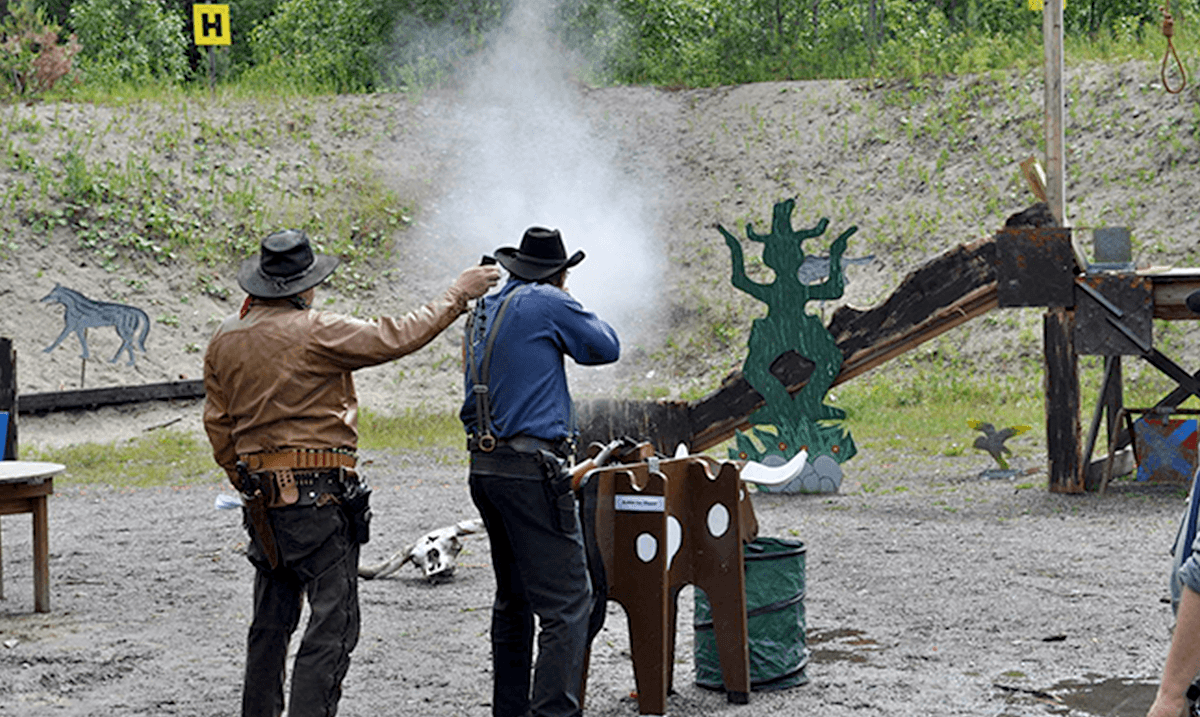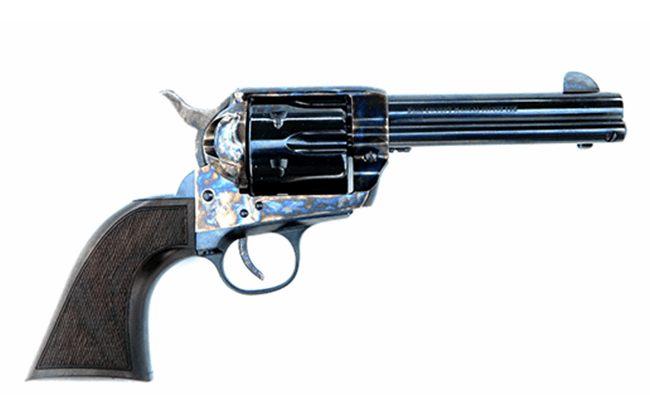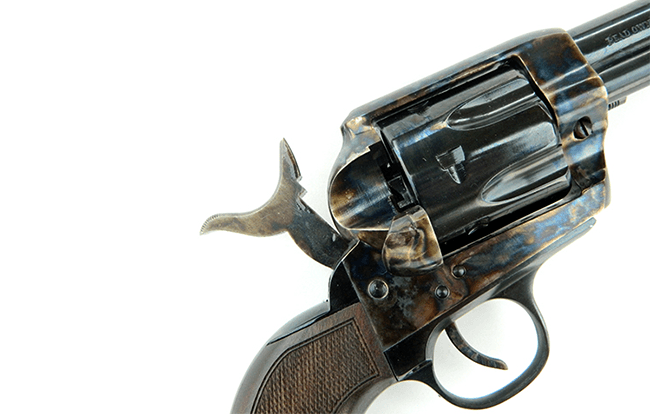
As Phil Massaro discussed in his piece on S&W revolvers, “wheelguns” can be divided by their action types to be classified as either single- or double-action. When it comes to the shooting sports and revolvers, the one where single-actions reign supreme is in the sport of Cowboy Action Shooting.
Single-Action Revolver Operation
Before we get into the sport of Cowboy Action Shooting, let’s talk a little about the stars of that show, the single-action revolvers. These are usually pretty easy to identify. Just think about an old western movie and the look of the handguns in them, how the shooter always had to cock the hammer to fire it. The smoke and mirror of Hollywood aside, that part’s accurate. With a single-action revolver, the hammer must be manually cocked back before the trigger can release it to fire the cartridge. After firing each round, the hammer must then be manually be cocked again, which rotates the cylinder to the next chamber and allows the user to shoot it again.
Most single-action revolvers are loaded via a “loading gate” on the right side of the gun. This is quite a different arrangement from today’s modern double-action revolvers, which have a release that allows the cylinder to freely swing away from the gun’s frame for loading and unloading. The loading gate is located directly behind the cylinder. When open, you load a single cartridge. Unloading is much the same. With the loading gate open, a rod adjacent to and in line with the barrel and the chamber in front of the loading gate is manipulated to push the spent shell (or live round) out of the gun.
That sounds simple enough, right? Well, almost. In truth, loading a single-action revolver safely and safely carrying one is more complicated than doing the same with a double-action. Let’s tackle the loading first.

The single-actions produced today by companies like Ruger and Uberti are faithful in styling to the guns of the Old West, but many now have added safety features the originals lacked. Pretty to look at either way and lots of fun to shoot, they are a staple of the sport of Cowboy Action Shooting.
So you have an unloaded, empty single-action revolver. You open the loading gate and slide in a round. From there, you will move the hammer to the “half-cock” position (and a reminder, as with all guns, only load with the muzzle of the gun pointed in a safe direction). This allows you to turn the cylinder of a single-action revolver to put the next empty chamber in line with the loading gate. (Note: Many currently produced single-action revolvers such as the Ruger Vaquero do not require the hammer to be at half-cock when loading. With a gun such as this, simply open the loading gate and rotate the cylinder with your fingers. As it is with all modern firearms, refer to your owner’s manual for complete safety and user instructions and contact your firearm’s manufacturer with any questions.)
Now, most single-action revolvers hold six rounds. To safely load, shoot and carry a single-action revolver, you will load only five rounds and the sixth, empty chamber will initially be positioned to be the one in front of the hammer and in line with the barrel. To do this, you will load one round into an empty gun, skip the next chamber, load the next four and close the loading gate. You will then, cock the hammer fully back and very carefully and with your thumb still on the hammer, gently depress the trigger and ease the hammer forward to its full, upright, uncocked position. If you’ve done this correctly, the empty chamber should now be in front of the hammer and in line with the barrel.
Why load only five rounds? Because the early single-action revolver design simply wasn’t safe enough to allow the gun to be carried with the hammer in the upright position (uncocked) and in line with a loaded cartridge. A good jarring or an accidental drop of the gun could fire the gun, even with the gun uncocked. Thankfully, many of today’s modern single-action revolvers, such as those made by Ruger, now have built-in safety features that do allow the user to load all six chambers, but since there are so many single-action revolvers in both the new and used market that do not have these added enhancements, the smartest thing to do is to load for five as described, carrying the gun with the hammer “down” (uncocked) on an empty chamber, but it should be noted that you should never carry a single-action revolver with the hammer down on a loaded chamber.
At the end of each shooting session, you’ll need to ensure your single-action is fully unloaded. Start by pointing the muzzle in a safe direction. Open the loading gate. Pull the hammer back to the half-cock position (if necessary). Then manually rotate the cylinder, using the ejection rod to remove spent casings or live rounds from each chamber hole as it lines up with the loading gate. When you are through, rotate the cylinder fully one more time and visually inspect to see that each chamber is empty.

A single-action revolver with the hammer at the half-cock position. Having the hammer in this position is a necessary part of the loading and unloading process on many single-actions. The “loading gate” is shown here in the open position, showing the scooped-out portion of the frame behind the cylinder, where the user will insert each new cartridge or extract spent cases one at a time after firing.
Cowboy Action Shooting — As ‘Old West’ as it Gets
The most enthusiastic shooters of single-action revolvers can be found in a group known as the Single Action Shooting Society or SASS. SASS endorses regional matches conducted by affiliated clubs and, in addition to providing matches that are great entertainment for both competitors and spectators alike, seeks to protect its members’ 2nd Amendment rights.
Also known as Cowboy Action Shooting, I have to advise you this: Don’t seek out a SASS group unless you are prepared to let down your hair and have an incredible amount of fun while safely shooting the firearms of the Old West. One of the unique aspects of SASS-approved Cowboy Action Shooting, which consist of timed shooting against a wide variety of targets, is the requirement placed on costuming. Yup, ya gotta dress up for this. Each participant is required to adopt a shooting alias — “Two-Eyed Black Jack,” “Double-Barrel Annie Oakley” and “Dirty Dry Gulch Dave,” etc. — appropriate to a character or profession of the late 19th century, Hollywood western star or appropriate character from western fiction. A competitor’s costume is then developed accordingly, with many event participants gaining as much enjoyment from the costuming aspect of the sport as they do from the shooting competition.
When it comes to participating in SASS competitions, the guns are as authentic as the costumes, with exposed hammer double-barrel “coach” shotguns and lever-action rifles, and there are even side matches for blackpowder firearms and the tiny two-barreled Derringer and other pocket pistols so popular during that era. But the stars of the show are the single-action revolvers. In fact, there are dozens of custom gunsmiths across the country that cater to the single-action SASS crowd, perfecting hammer and trigger actions and making these guns the most accurate they can be. This is especially important to those competing in horseback-mounted SASS competitions — yes, live, galloping horses! — because those marksmen and -women shoot on the move!
You’ll find SASS participants to be passionate and very welcoming to newcomers, so don’t get spooked by the costume or feel the need to throw on an old set of borrowed chaps or a petticoat, just check out a local shoot and find someone will to walk you through your first shots with a single-action revolver. For more information in getting involved in SASS, visit www.sassnet.com or contact the good folks at the organization’s New Mexico office at 505-843-1320.





